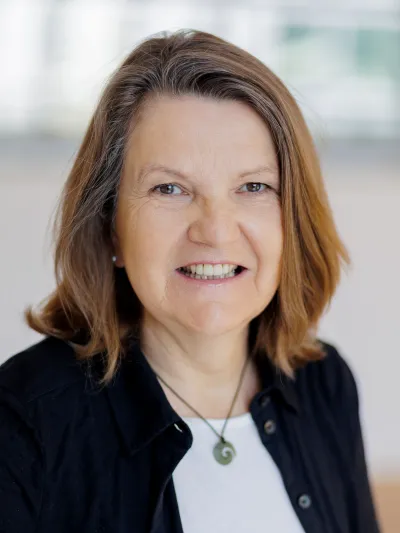Retrospective
The Artists' Archive of the Berlinische Galerie – An Archive as Part of a Museum

"Why stop when it's at its best?" Sharon Hundehege and Paula Weyrauch visit the artists' archive at the Berlinische Galerie.
A look behind the scenes of cultural archives – This is what students of information science were able to do as part of a seminar held by Prof. Dr. Freund in the second block week of the 2023/2024 winter semester. The excursions showed the students how cultural archives differ from other types of archives and gave an insight into their highly diverse collections. However, difficulties such as funding and digitisation were also addressed. By the end of the block week, the students had visited three cultural archives: the Mediathek für Tanz und Theater am Künstlerquartier Bethanien, the Baukunstarchiv der Akademie der Künste and the Archiv für Film- und Medienkunst der Akademie der Künste. Nevertheless, the broad field of cultural archives was still more outlined than penetrated. So why stop when it's at its best?
In the following, Sharon Hundehege and Paula Weyrauch present the artists' archive of the Berlinische Galerie. The insight was made possible by Philip Gorki, who guided the students through the building and the archive and familiarised them with "his" archive.
The building – a MoMa for Berlin
The artists' archive has been housed in the new building at Alte Jakobstraße 124 – 128 since 2004. As with many archive buildings, this is not a purpose-built archive – during the division of Germany, West Berliners stored their window glass here in order to have it on hand in the event of a blockade. Although the building was not built with the ideal of a purpose-built archive in mind, today it achieves a fantastic standard thanks to its good building fabric and technical solutions: for example, the temperature in the depots where the photographs are stored is a constant 18°C. A speciality in Berlin, as Gorki reports.
Like many cultural archives, there is not enough space in the museum planned as Berlin's MoMA to give everything its own room, which is why it has to be well organised: For example, there is no separate study room for users, it is simultaneously a restoration workshop, a workplace for the archivists and project staff and, at the end, has a small photo studio where the objects are digitised. A museum/archive/library – all under one roof.
Like many cultural institutions, the Berlinische Galerie offers its visitors a wide range of opportunities to engage with its theme. However, this also means that many interested parties have a seat at the table when it comes to the distribution of funds. Money for the acquisition of new archive materials or estates is therefore not certain. As is so often the case, there is not enough money for the permanent employment of additional archive staff anyway. According to Mr. Gorki, this is why third-party funding is also used, i.e. additional employees are kept and paid in the archive via projects. There are currently two permanent archivists, including Mr. Gorki. The division of resources also affects the work of the restoration workshop, which occasionally has to prioritise exhibition objects over archive materials.
Berlin art and artists – the holdings of the Artists' Archive
The core of the Berlinische Galerie's archive is formed by the estates of Raoul Hausmann and Hannah Höch, both central figures of the Dada movement. However, the archive's focus is not solely on the artists of Dadaism, even though it certainly has the world's most comprehensive collection on this movement: The connection to the city of Berlin is particularly important. It is no longer only the estates of artists that are included in the archive, but also those of art dealers. Researchers can therefore explore the field of art from different perspectives. The archives of the Künstler*innenarchiv illustrate the wide range of what can be worth archiving.
When asked about his favourite archival item, Mr. Gorki only answers after a long pause for thought, due to the mass of possible choices, and finally names three:
- Hannah Höch's address book, which she kept between 1920 and 1970. Philip Gorki is particularly fascinated by how the artist's handwriting changed over time and that Hausmann's address only found its way into the pocket book after the end of their love affair.
- The curls of Marta Astfalck-Vietz's deceased dog, which for him are a curious example of "living remains".
- And finally, Lotte Laserstein's sketchbook, which provides an insight into the artist's creative process.
An insight into the range of the Berlinische Galerie's artist archive can be gained not only by visiting the archive, but also in the exhibitions. The archive always exhibits self-selected objects in the glass cases, which complement the exhibited objects.
Sharon Hundehege and Paula Weyrauch recommend a visit to the Berlinische Galerie and would like to thank Philip Gorki for the eloquent, exciting and detailed tour of the archive.
An article by Sharon Hundehege and Paula Weyrauch
